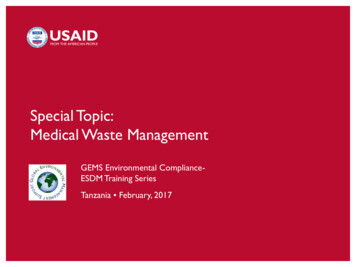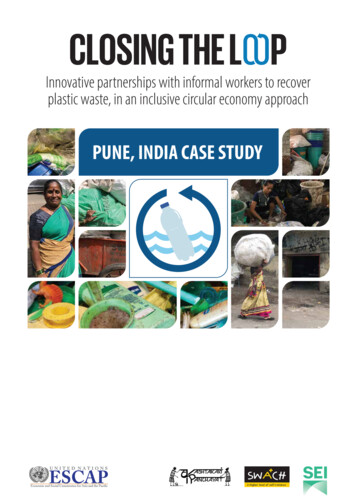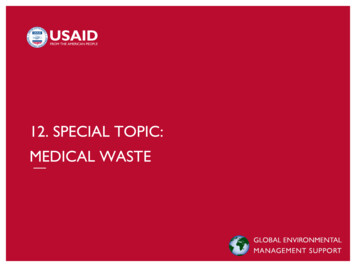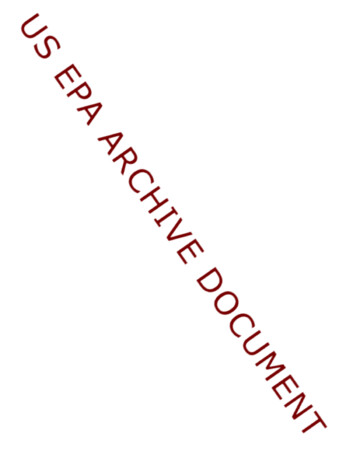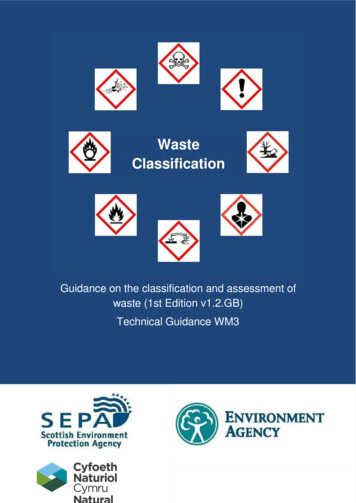
Transcription
WasteClassificationGuidance on the classification and assessment ofwaste (1st Edition v1.2.GB)Technical Guidance WM3
Publishing OrganisationsNatural Resources Wales /Cyfoeth Naturiol Cymru,Tŷ Cambria,29 Newport Road,Cardiff,CF24 0TP.Scottish Environment Protection Agency (SEPA),SEPA Corporate OfficeStrathallan HouseCastle Business ParkStirlingFK9 4TZ,Tel: 0300 065 3000Tel: 01786 457700Fax: 01786 .ukEnvironment Agency,Horizon House,Deanery Road,Bristol,BS1 5AH.Tel 03708 environment-agencyDocument HistoryFirst Edition :Version 1.1:Version 1.1.GBJan 2021 (EU Exit Update)Version 1.2.GBOct 2021 (Appendix B Update)May 2015May 2018Adapted from the third edition of technical guidance WM2.
ContentsSectionTitlePageContents1Chapter 1Introduction3Chapter 2Waste classification and assessment5Chapter 3Further guidance on assessment19Appendix AHow to use the List of WasteA1Appendix BHazardous substancesB1Appendix CHazardous property assessmentC1: Explosive HP 1C2: Oxidizing HP 2C3:Flammable HP 3C4: Irritant HP 4C5: Specific Target Organ Toxicity/Aspiration Toxicity HP 5C6: Acute Toxicity HP 6C7: Carcinogenic HP 7C8: Corrosive HP 8C9: Infectious HP 9C10: Toxic for Reproduction HP 10C11: Mutagenic HP 11C12: Produces toxic gases in contact with water, air or acid HP 12C13: Sensitising HP 13C14: Ecotoxic HP 14C15: HP15 (capable of exhibiting a hazardous property listed above notdirectly displayed by the original waste)C16: Persistant Organic PollutantsAppendix DWaste 52C54D1Waste Classification: Guidance on the classification and assessment of waste (1st Edition v1.2.GB)1
List of AbbreviationsAHANATPAbsolute hazardousAbsolute non-hazardousAWCCTBaPAsphalt waste containing coal tarBenzo[a]pyreneBSICASBritish Standards InstituteChemical Abstract ServiceCENCFCEuropean Committee for StandardisationChlorofluorocarbonCLIClassification and Labelling InventoryCLPECClassification, Labelling and Packaging of Substances Regulation (GB or EU)European CommunityECHAEuropean Chemicals AgencyECVAMEuropean centre for the validation of alternative methodsEuropean Economic CommunityEECELVEUEnd of Life VehicleEuropean UnionHCFCGlobally Harmonised SEHealth and Safety ExecutiveIARCInternational Agency for Research on CancerLoWLoWDMCLMFSUMHMNNIEAPAHList of tation to technical progressList of Wastes Decision (2002/532/EC)Mandatory Classification List, under the GB CLP RegulationManufacture, formulation, supply and use.Mirror hazardousMirror non-hazardousNorthern Ireland Environment AgencyPolycyclic Aromatic HydrocarbonsPolychlorinated BiphenylsPersistent Organic PollutantRegistration, evaluation, authorisation and restriction of chemicals (UK or EU)Safety Data SheetScottish Environment Protection AgencySecretary of StateStandard temperature and pressure (25ºC and 1 atmosphere pressure)Total Petroleum HydrocarbonsWaste electronic and electrical equipmentWaste Framework Directive (2008/98/EC)X-Ray DiffractionWaste Classification: Guidance on the classification and assessment of waste (1st Edition v1.2.GB)
IntroductionOverviewAs part of your waste duty of care you must classify the waste your business produces: before it is collected, disposed of or recovered to identify the controls that apply to the movement of the waste to complete waste documents and records to identify suitably authorised waste management options to prevent harm to people and the environment.You should use this version (1.1.GB) of the guidance if you produce, manage or regulate waste inEngland, Scotland or Wales. If you are in Northern Ireland you should use version 1.1.NI instead.For most wastes, you will need to identify if the waste has a hazardous property before you canclassify or describe it.This guidance explains how to assess if the waste displays a hazardous property and how toclassify it.Chapter 2 provides the procedure for waste classification and assessment. This procedure uses thesupporting information provided in five appendices as shown below.Chapter 2: Waste classification and assessmentChapter 3: Further guidance on assessmentProvides examples of the assessment of asbestos, oil and coal tarcontaining wastes and soil.Appendix A: How to use the List of WasteExplains how to use the List of Waste, including some examples.Appendix B: Hazardous substancesExplains how to identify if a substance is a hazardous substance.Appendix C: Hazardous property assessmentExplains how to identify if a waste displays one or more hazardousproperties or is hazardous because it contains persistent organic pollutants.Appendix D: Waste samplingProvides guidance on how to plan the sampling of a waste to produce anaccurate classification.Waste Classification: Guidance on the classification and assessment of waste (1st Edition v1.2.GB)3
2Waste classification and assessmentIntroductionThis chapter explains how to classify a waste and identify its hazardous properties.You need to classify each waste so you can describe it. The classification: must be worked out before the waste is moved, disposed of or recovered must be included on waste documents and records determines the controls that apply to movement of the waste is needed to identify a suitably authorised waste management optionSome examples of the classification of common wastes (for England) are provided pes-of-waste/overviewWaste classification and assessment procedureSteps to classify the waste1.check if the waste needs to be classified2.identify the code or codes that may apply to the waste3.identify the assessment needed to select the correct codeSteps to assess the waste4.determine the chemical composition of the waste5.identify if the substances in the waste are ’hazardous substances’ or ’Persistent OrganicPollutants’6.assess the hazardous properties of the waste7.assign the classification code and describe the classification codeThis procedure is a general guide, it applies in most circumstances and must be used with thesupporting appendices. If you’re unsure seek advice from a competent person.Step 1: Check if the waste needs to be classifiedYou need to ensure the material is waste, and needs to be classified.Nearly all household, commercial and industrial wastes do need to be classified. This includes wastefrom domestic households.The material does not need to be classified if it’s either: not waste, or a waste that is excluded from classificationSee box 2.1 for wastes excluded from classification entirely, or excluded where they are covered byseparate legislation.If the waste you’re trying to classify is listed in Box 2.1, check domestic legislation to see how thesewastes are regulated in each country. This is particularly important if the waste is radioactive orexcluded by Article 2(2) of the Waste Directive.See the Legal definition of waste guidance - Publications - GOV.UK for additional guidance on what iswaste and the listed exclusions for England, Wales and Northern Ireland.If the material is waste, and needs to be classified, proceed to step 2.4Waste Classification: Guidance on the classification and assessment of waste (1st Edition v1.2.GB)
Box 2.1: Text from Article 2 of the Waste Directive - Exclusions from the Scope‘1: The following shall be excluded from the scope of this Directive:a) gaseous effluents emitted into the atmosphere;b) land (in situ) including unexcavated contaminated soil and buildings permanently connectedwith land;c) uncontaminated soil and other naturally occurring material excavated in the course ofconstruction activities where it is certain that the material will be used for the purposes ofconstruction in its natural state on the site from which it was excavated;d) radioactive waste;e) decommissioned explosives;f) faecal matter, if not covered by paragraph 2(b), straw and other natural non-hazardousagricultural or forestry material used in farming, forestry or for the production of energy fromsuch biomass through processes or methods which do not harm the environment orendanger human health.2: The following shall be excluded from the scope of this Directive to the extent that they arecovered by other Community legislation:a) waste waters;b) animal by-products including processed products covered by Regulation (EC) No1774/2002, except those which are destined for incineration, landfilling or use in a biogas orcomposting plant;c) carcasses of animals that have died other than by being slaughtered, including animalskilled to eradicate epizootic diseases, and that are disposed of in accordance withRegulation (EC) No 1774/2002;d) waste resulting from prospecting, extraction, treatment and storage of mineral resourcesand the working of quarries covered by Directive 2006/21/EC of the European Parliamentand of the Council of 15 March 2006 on the management of waste from extractiveindustries’ (see note below).‘3: Without prejudice to obligations under other relevant Community legislation, sediments relocatedinside surface waters for the purpose of managing waters and waterways or of preventing floods ormitigating the effects of floods and droughts or land reclamation shall be excluded from the scope ofthis Directive if it is proved that the sediments are non-hazardous.’Note: The Mining Waste Directive (2006/21/EC) uses the definition of hazardous waste. Referencesin this document to ‘directive waste’ includes waste within the scope of the Mining Waste Directive.Step 2: identify the code or codes that may apply to the wasteThe second step is to identify how the waste is classified in the List of Waste (LoW).This classification identifies what assessment is needed before a LoW code can be assigned to thewaste.List of Waste (LoW) is a catalogue of all wastes divided into 20 chapters. The chapters must be usedin the correct order of precedence.The chapters contain both the classification codes and the descriptions of each code (togetherreferred to as an ‘entry’ in the list)You need to read Appendix A which: contains a copy of the List of Waste (includes the code, it’s description, entry type andwhether there is a worked example available) explains how to use the list provides information on the different types of entry and how each is assessedThis will help you identify the most appropriate code(s). Some codes are linked so it’s common toidentify more than one code at this stage.Waste Classification: Guidance on the classification and assessment of waste (1std Edition v1.2.GB)5
Once you’ve done this you proceed to step 3.Step 3: identify the assessment needed to select the correct code(s)You now need to work out if an assessment is needed and how it affects the classification of thewaste.The assessment needed depends on the type of code(s) identified. Codes are divided into four typesof entry: wastes that may be hazardous or non-hazardous, known as ’mirror hazardous’ and ’mirrornon-hazardous’ entries wastes that are always hazardous, known as ’absolute hazardous’ entries wastes that are always non-hazardous, known as ’absolute non-hazardous’ entries.The information provided in this guidance is suitable for most wastes. In a few cases the list of wastescontains complex linkages between several entries of different types – you should seek further adviceabout these. You must consider all relevant linked entries in order of precedence - see Appendix Afor further information.‘mirror hazardous’ or ‘mirror non-hazardous’ entriesIf the waste is classified under ‘mirror hazardous’ or ‘mirror non-hazardous’ entries you will need tocontinue with the assessment of hazardous properties in steps 4 to 7. This will be used to identify which code applies, and complete the hazardous waste consignment note.Waste holders have a duty to determine if a “mirror entry” waste is hazardous or non-hazardous. Alist of waste code cannot be assigned until steps 4 to 7 have been completed.Appendix A also gives additional advice on how mirror entries that refer generally to hazardoussubstances or only to one specific hazardous substance are assessed.‘absolute hazardous’ entryIf a waste is classified as an ‘absolute hazardous’ entry, you must use that code. The waste ishazardous waste and further assessment cannot change the classification. Steps 4 to 7 are not usedfor classification purposes.You must assess your waste to determine which hazardous properties it displays to complete ahazardous waste consignment note. Follow steps 4 to 7 for hazardous property assessmentThere are exceptions where ‘absolute hazardous’ entries are linked to other entries and additionalconsideration may be needed. The other entries may need to be considered to determine if they aremore appropriate to the waste.You can find additional advice in Appendix A on how unusual entries of this type, for example thosethat relate to the presence or absence of hazardous components, are applied.‘absolute non-hazardous’ entriesIf a waste is classified as an ‘absolute non-hazardous’ entry, in most cases it is non-hazardouswithout any further assessment and you can proceed to Step 7.There are exceptions where these ‘absolute non-hazardous’ entries are linked to other entries andadditional consideration may be needed. The other entries may need to be considered to determine ifthey are more appropriate to the waste.In Appendix A additional advice is given on how certain atypical entries of this type are applied, forexample entries that relate to the presence or absence of hazardous components.6Waste Classification: Guidance on the classification and assessment of waste (1st Edition v1.2.GB)
Step 4: determine the chemical composition of the wasteTo assess whether the waste has a hazardous property you first need to know its composition.You can get information on the composition of a waste: from the manufacturers safety data sheet if the waste is a manufactured product whosecomposition has not changed - if the composition has been altered during storage or use youshould not rely fully on this information when the waste is from a well understood industrial process and the composition of thewastes produced are well understood. by sampling and analysing the waste to determine its composition – you must read AppendixD before undertaking any sampling, to ensure that sampling is appropriate, representative andreliableChemical analyses (particularly for inorganic substances) do not always identify the specificcomponents but may only identify the individual anions and cations. In such cases, the waste holdermay need to determine what precise substances are likely to be present either by further analysis orby applying knowledge of the process / activity that produced the waste. If there is any doubt, theworst case substance should be considered to be present. See step 5 for further information on‘worst case’ substances.Once you’ve determined the composition proceed to step 5.What to do if you do not know the composition of the wasteYou should make all reasonable efforts to determine the composition of the waste.This information is required to both: classify mirror entry wastes complete a consignment note for hazardous waste prior to the waste being removed from thepremises of productionWhere the composition of a mirror entry waste is not known and genuinely cannot be determined themirror entry waste must be classified under the ‘mirror hazardous’ entry.Although direct testing methods are available for some hazardous properties (for exampleflammability) in step 6, they are not available for all properties. So direct testing cannot be used toclassify a waste of unknown composition as non-hazardous.Step 5: identify if the substances in the waste are ‘hazardous substances’ or‘Persistent Organic Pollutants’Once you have determined the chemical composition you need to check if any of those chemicals are ‘hazardous substances’, or persistent organic pollutants (POPs)Appendix B explains how to identify if a substance is a ‘hazardous substance’ and the hazardstatement codes assigned to it.Box 2.2 lists the POPs that are used for waste classification and have to be considered in step 6.Waste Classification: Guidance on the classification and assessment of waste (1st Edition v1.2.GB)7
Box 2.2 Persistant Organic Pollutants used for waste classificationpolychlorinated dibenzo-p-dioxins anddibenzofurans (PCDD/PCDF),hexaclorobenzene,chlordecone,DDT (1,1,1-trichloro-2,2-bis robenzene,hexachlorocyclohexanes (including ,hexabromobiphenylpolychlorinated biphenyls (PCB’s)Once you have determined if any of the substances in the waste are hazardous substances or POPsproceed to step 6.If the composition of the waste is known and none of the substances in the waste are hazardoussubstances or POPs (listed in Box 2.2) then the waste does not possess any hazardous properties.Proceed to step 7.‘Worst case’ substanceWhere the holder has some knowledge of the components (for example ‘lead’ and ‘chromium’), butdoes not know which specific substances, are present they must identify the ‘worst case’ substance(s)(for example ‘lead chromate’) for each component for use in Step 6.The worst case substance should be determined separately for each hazardous property and is thesubstance, or combination of substances, that may reasonably exist in the waste and that is mostlikely to result in each hazardous property applying.The worst case substance can be different for each hazardous property. For example, if chemicalsubstance A has a carcinogenic hazard statement code and chemical substance B has a mutagenichazard statement code both substances would have to be considered (one for each of the twohazardous properties).The term ‘reasonable’ indicates that substances that cannot exist within the waste because, forexample, of their physical and chemical properties can be excluded.Step 6: Assess the hazardous properties of the wasteIn step 6 you must consider all hazardous properties. These are numbered HP 1 to HP 15.There are three methods to work out if a waste displays hazardous properties. These are: calculation - referring to a concentration limit for a hazard statement code (s), testing to prove whether a particular hazardous property is present or not (typically used forthe physical properties – explosive, oxidising, and flammable), or the safety data sheet if the waste is a manufactured product whose composition has notchanged, for that specific product.At this point you should know what substances are present in the waste (or have assumed the worstcase substances) and what hazard statement codes they have. These hazard statement codesdetermine what hazardous properties you need to consider. Table 2.1 shows which hazardousproperties are associated with each hazard statement code and where appropriate a concentrationlimit. See Appendix C for instructions on how to assess each hazardous property, based on thesehazard statement codes.8Waste Classification: Guidance on the classification and assessment of waste (1st Edition v1.2.GB)
If the waste is classified under a ‘mirror hazardous’ and ‘mirror non-hazardous’ entry you must alsoconsider POPs at this stage. Appendix C16 lists the POPs you must consider, and the concentrationlimit that applies to each.Products are often labelled with hazard pictograms (see Table 2.2). If a pictogram is present ahazardous property is likely to apply. The absence of a pictogram does not mean that there are nohazardous properties.See chapter 3 for examples of assessing hazardous properties for construction and demolition wastecontaining coal tar or asbestos, waste soil, waste oil and wastes containing oil.Mirror entries referring to a specific hazardous substance or propertySome mirror entries in the LoW refer to a specific hazardous substance or a specific hazardousproperty.For these entries assessing the hazardous properties must be done in two stages.The first step (used for classification) is to assess the waste to determine if it displays:a hazardous property due to the specific substance named in the entry, orthe specific hazardous property named in the entryor contains POPs at or above the concentration limitIf the waste does display a hazardous property or contains POPs, then as the second step you mustconsider all the hazardous properties and hazardous substances. This is used to complete theconsignment note.Step 7: assign the classification code and describe the hazardous propertiesAt this stage the types of entries identified in steps 2 and 3 are important.If you have identified entries with a different order of precedence (see Appendix A) you must considerthe entries in that order of precedence. You can only consider an entry with a lower order ofprecedence if no appropriate entry exists at the higher level.If the waste is classified under an ‘absolute hazardous’ entry: you must use the classification code provided the waste is hazardous waste hazardous property assessment is not used for classification purposes the composition and hazardous properties identified in steps 4 to 6 are used only to completethe consignment noteKey Point : ‘absolute hazardous’ wastes with no hazardous propertiesA waste that falls under an absolute hazardous entry (eg any non-edible oil) is always hazardous.That entry must be used.If that waste has no hazardous properties the absolute hazardous entry still applies. The law does notallow another entry to be applied to that waste.If the waste was classified under ‘mirror hazardous’ and ‘mirror non-hazardous’ entries that refergenerally to hazardous substances, then: the ‘mirror hazardous’ code must be assigned if the waste displays a hazardous property orcontains POPs above the specified concentration limits the waste is hazardous waste, and the composition, hazardous properties, and POPs identified in steps 4 to 6 are also used tocomplete the consignment noteWaste Classification: Guidance on the classification and assessment of waste (1st Edition v1.2.GB)9
when the waste does not display a hazardous property, and does not contain POPs, the‘mirror non-hazardous’ code can be assignedIf the waste was classified under ‘mirror hazardous’ and ‘mirror non-hazardous’ entries that refer to aspecific hazardous substance or hazardous property, then: the ‘mirror hazardous’ code must be assigned if the waste displays a hazardous property as aresult of that specific substance, displays that specific property, or contains POPs above thespecified concentration limits the waste is hazardous waste, and the composition, all hazardous properties, and POPs identified in steps 4 to 6 are then usedto complete the consignment note when the waste does not display a hazardous property as a result of the specific substance,does not display the specific hazardous property, and does not contain POPs, the ‘mirror nonhazardous’ code can be assignedIf the waste was classified under an ‘absolute non-hazardous’ entry, noting the additional advice givenin step 3 and appendix A, you must use the absolute non-hazardous code. The waste should bemanaged in line with Duty of Care Regulations and other applicable legislation. If a waste classified as‘absolute non-hazardous’ displays a hazardous property you must include this on the waste transfernote. If you believe an ‘absolute non-hazardous’ waste may display a hazardous property, usesteps 4 to 6 to assess this.10Waste Classification: Guidance on the classification and assessment of waste (1st Edition v1.2.GB)
Table 2.1Hazardous properties and hazard statement codesWaste Classification: Guidance on the classification and assessment of waste (1st Edition v1.2.GB)11
12Waste Classification: Guidance on the classification and assessment of waste (1st Edition v1.2.GB)
Waste Classification: Guidance on the classification and assessment of waste (1st Edition v1.2.GB)13
14Waste Classification: Guidance on the classification and assessment of waste (1st Edition v1.2.GB)
Waste Classification: Guidance on the classification and assessment of waste (1st Edition v1.2.GB)15
Table 2.2Hazard pictograms, hazard classes, and hazardous propertiesPictogramPhysical hazard classesHazardouspropertiesUnstable explosivesExplosives, divisions 1.1, 1.2, 1.3, 1.4Self-reactive substances and mixtures, types A, BHP1 ExplosiveOrganic peroxides, types A, BOxidizing gases, category 1Oxidizing liquids, categories 1, 2, 3HP 2 OxidisingOxidizing solids, categories 1, 2,Flammable gases, category 1Flammable aerosols, categories 1, 2Flammable liquids, categories 1, 2, 3Flammable solids, categories 1, 2Self-reactive substances and mixtures, types B, C, D, E, FPyrophoric liquids, category 1HP 3 FlammablePyrophoric solids, category 1Self-heating substances and mixtures, categories 1, 2Substances and mixtures, which in contact with water, emitflammable gases, categories 1, 2, 3Organic peroxides, types B, C, D, E, FNo pictogramExplosive, division 1.5HP 15Explosive, division 1.6Not applicableFlammable gas, category 2HP 3 FlammableSelf-reactive substances and mixtures, type GNot applicableOrganic peroxides, type GNot applicableCompressed gasesLiquefied gasesRefrigerated liquefied gasesDissolved gases16Waste Classification: Guidance on the classification and assessment of waste (1st Edition v1.2.GB)No hazardousproperty
PictogramHuman health hazard classesHazardouspropertiesSkin corrosion, category 1AHP 4 IrritantHP 8 CorrosiveSkin corrosion, categories 1B and 1CHP 8 CorrosiveSerious eye damage, category 1Corrosive to metalsHP 4 IrritantNot applicableAcute toxicity (oral, dermal, inhalation), categories 1, 2, 3HP 6 Acute ToxicityRespiratory sensitization, category 1HP 13 SensitisingGerm cell mutagenicity, categories 1A, 1B, 2HP 11 MutagenicCarcinogenicity, categories 1A, 1B, 2Reproductive toxicity, categories 1A, 1B, 2Specific target organ toxicity following single exposure, categories1, 2Specific target organ toxicity following repeated exposure,categories 1, 2HP 7 CarcinogenicHP 10 Toxic forreproductionHP 5 Specific TargetOrgan Toxicity /Aspiration ToxicityAspiration hazard, categories 1, 2Acute toxicity (oral, dermal, inhalation), category 4Skin irritation, categories 2, 3HP 6 Acute ToxicityHP 4 IrritantEye irritation, category 2Skin sensitization, category 1Specific target organ toxicity following single exposure, cat. 3No pictogramNot subject tochemicallabellingrequirements Respiratory tract irritation Narcotic effectsHP 13 SensitisingHP 5 Specific TargetOrgan Toxicity /Aspiration ToxicityAcute toxicity (oral, dermal, inhalation), category 5Not applicableReproductive toxicity – effects on or via lactationNot applicableNot applicableHP 9 InfectiousWaste Classification: Guidance on the classification and assessment of waste (1st Edition v1.2.GB)17
PictogramEnvironmental hazard classesHazardouspropertiesHazardous to the aquatic environment – acute aquatic hazard,category 1Hazardous to the aquatic environment – long-term aquatic hazard,category 1, 2No pictogram18HP 14 EcotoxicHazardous to the ozone layerHP 14 EcotoxicHazardous to the aquatic environment – acute aquatic hazard,categories 2, 3.HP 14 EcotoxicHazardous to the aquatic environment – long-term aquatic hazard,categories 3, 4HP 14 EcotoxicWaste Classification: Guidance on the classification and assessment of waste (1st Edition v1.2.GB)
3Further guidance on assessmentThis chapter provides further guidance and examples to show how waste classification andassessment is applied to1. Construction and demolition wastes containing asbestos2. Waste containing coal tar3. Waste soils4. Waste oils and other wastes containing or contaminated with oil(a) Waste oils(b) and other wastes containing or contaminated with oil1. Construction and demolition wastes containingasbestosAsbestos is a naturally occurring silicate mineral and exists in a number of chemical types – forexample chrysotile (‘white’), amosite (‘brown’) and crocidolite (‘blue’) – either in a bonded or fibrousform. The fibres are very fine, less than 3 microns in diameter and respirable into the lungpassageways where they can lodge indefinitely and penetrate tissue.All forms of asbestos are classified the same way in the Mandatory Classification List (MCL) underthe GB CLP Regulation: Carc. Cat 1A; H350, and STOT RE1; H372**The assessment of asbestos containing waste considers both the presence of asbestos as fibres that are free and dispersed, and identifiable pieces of asbestos containing materialIf the waste contains fibres that are free and dispersed then the waste will be hazardous if the wasteas a whole contains 0.1% or more asbestos.If the waste contains any identifiable pieces of suspected asbestos containing material they must beassessed as set out below. This would also apply to any dispersed fibres produced by deliberatelybreaking up such identifiable pieces.Where the waste contains identifiable pieces of asbestos containing material (i.e. any particle of asize that can be identified as potentially being asbestos by a competent person if examined by thenaked eye), then these pieces must be assessed separately. The waste is hazardous if theconcentration of asbestos in the piece of asbestos containing material is 0.1% or more. The waste isregarded as a mixed waste and classified accordingly (see example 1 for advice on how to apply listof waste codes to mixed waste). The following codes should be assigned to the asbestos waste asappropriate: 17 06 05* Construction material containing asbestosMH 17 06 01* Insulation material containing asbestosMH17 06 05* would normally be used in preference to 17 06 01* for the asbestos in asbestoscontaminated soil and stones.2. Waste containing coal tarThis example p
Codes are divided into four types of entry: wastes that may be hazardous or non-hazardous, known as 'mirror hazardous' and 'mirror non-hazardous'entries wastes that are always hazardous, known as.








